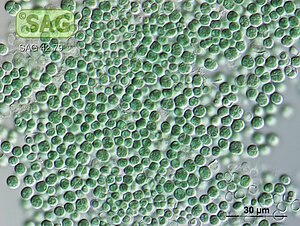Chroococcidiopsis
| Chroococcidiopsis | ||||||||||||
|---|---|---|---|---|---|---|---|---|---|---|---|---|

|
||||||||||||
| Systematics | ||||||||||||
|
||||||||||||
| Scientific name | ||||||||||||
| Chroococcidiopsis | ||||||||||||
| Geitler 1933 |
Chroococcidiopsis [ ˌkroːoˌkɔktsidiɔpsɪs ] is a genus photosynthesis operator acting as cyanobacteria .
The species of the genus Chroococcidiopsis are among the most unusual organisms. They are known for their ability to grow, or at least survive, in virtually any environmental condition that occurs on earth. The bacteria were found in the hottest and driest deserts on earth, in high mountains, salt lakes, hot springs, in the icy Ross Desert of Antarctica and even endolithically in the interior of rocks.
Chroococcidiopsis species tolerate high levels of radiation, extreme temperatures, dehydration, osmotic stress and extreme pH levels . All that is necessary for survival is light, carbon dioxide , a minimum of water and trace elements . The bacteria can meet their nitrogen requirements by fixing molecular nitrogen from the atmosphere.
The unicellular organisms are therefore regarded as ideal organisms for the initial colonization of inanimate celestial bodies. This idea belongs to a process called " terraforming ", in which a moon or planet is to be made habitable for humans: even under inhospitable conditions, Chroococcidiopsis could release oxygen from water through photosynthesis and thus contribute to the formation of a breathable atmosphere or by binding carbon dioxide Counteract the greenhouse effect. In addition, the bacteria could produce biomass, form humus and create the conditions for colonization by other organisms and humans. It is debated whether Chroococcidiopsis could survive on Mars and colonize it successfully. Finally, the bacteria could also be genetically modified in a targeted manner and adapted even better to environmental conditions on other celestial bodies.
Chroococcidiopsis is the 2017 Alga of the German Botanical Society .
Systematics
The genus currently comprises 16 species . (Status: February 2016)
- Chroococcidiopsis bourrellyana Compère
- Chroococcidiopsis codiicola Beljakova
- Chroococcidiopsis cubana Komárek & Hindák
- Chroococcidiopsis doonensis R.B.Singh
- Chroococcidiopsis edaphica J.R. Johannesen & Flechtner
- Chroococcidiopsis fissurarum ( Ercegovic) Komárek & Anagnostidis
- Chroococcidiopsis indica Desikachary
- Chroococcidiopsis karnatakensis Gonzalves & Kamat
- Chroococcidiopsis kashayi Friedmann
- Chroococcidiopsis mysorensis Tiwari
- Chroococcidiopsis polansiana Andersen
- Chroococcidiopsis spinosa Kamat
- Chroococcidiopsis supralittoralis I.Dor, N.Carl & I.Baldinger
- Chroococcidiopsis thermalis Geitler
- Chroococcidiopsis umbratilis I.Dor, N.Carl & I.Baldinger
- Chroococcidiopsis versatilis I.Dor, N.Carl & I.Baldinger
Individual evidence
- ↑ Ancient and always a pioneer: Blue-green rock ball is Alga of the Year 2017. Press release, Phycology Section of the German Botanical Society (DBG), January 4, 2017.
- ↑ Chroococcidiopsis - In: Guiry, MD; Guiry, GM: AlgaeBase. National University of Ireland, Galway, last accessed February 3, 2016.
Web links
- Terraforming on Mars
- Algaebase entry Chroococcidiopsis Geitler 1933
